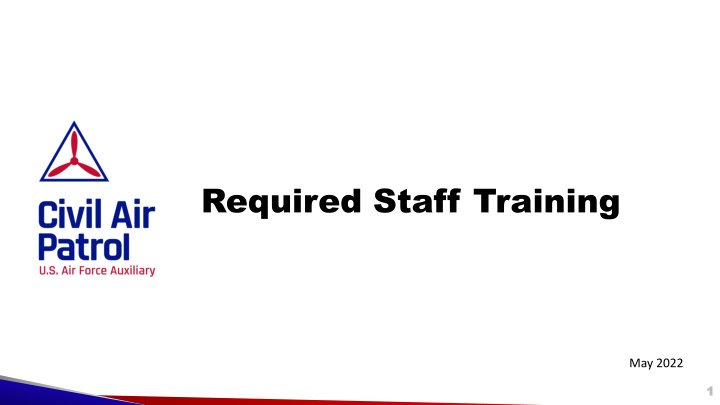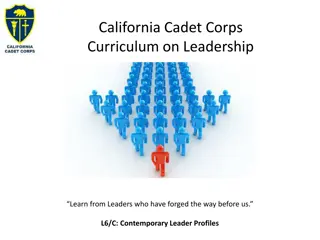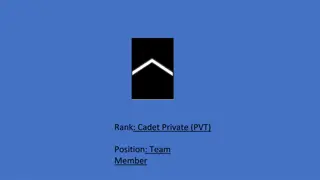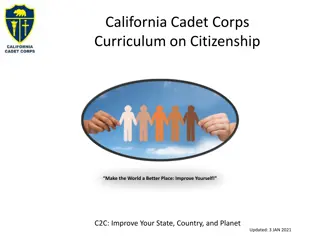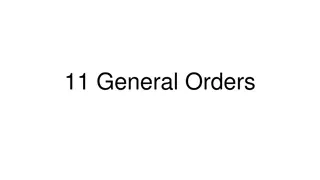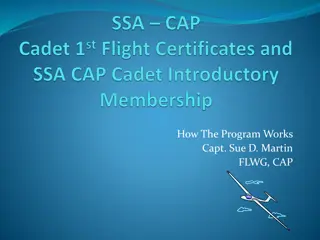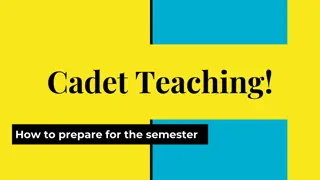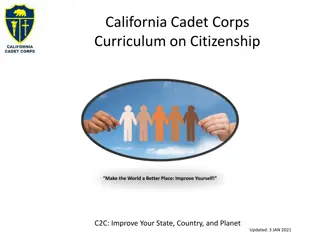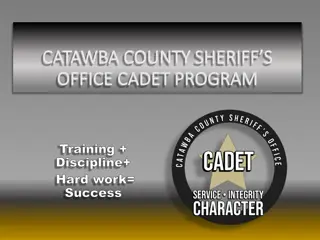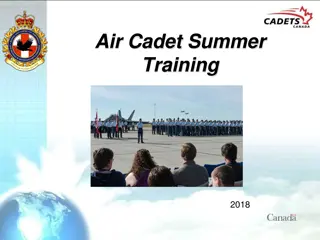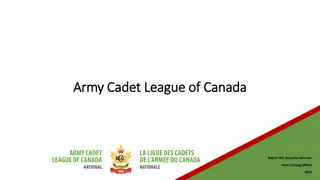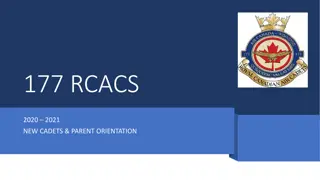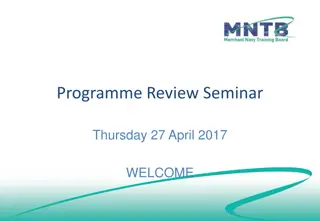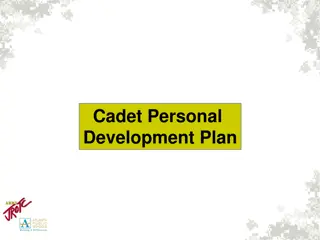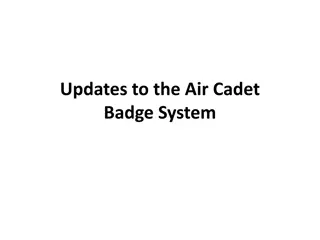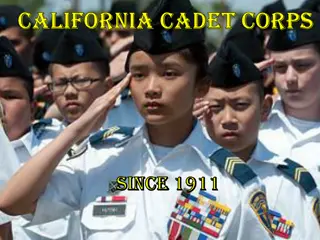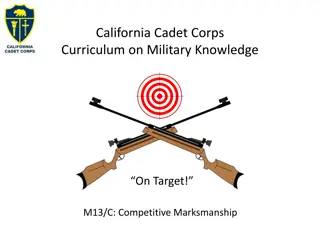Essential Cadet Protection Training Overview
Explore the imperative cadet protection training for staff, emphasizing a team mentality and high standards. Delve into the Cadet Protection Paradigm, intensity levels, and abuse definitions to ensure the safety and well-being of cadets.
Download Presentation

Please find below an Image/Link to download the presentation.
The content on the website is provided AS IS for your information and personal use only. It may not be sold, licensed, or shared on other websites without obtaining consent from the author.If you encounter any issues during the download, it is possible that the publisher has removed the file from their server.
You are allowed to download the files provided on this website for personal or commercial use, subject to the condition that they are used lawfully. All files are the property of their respective owners.
The content on the website is provided AS IS for your information and personal use only. It may not be sold, licensed, or shared on other websites without obtaining consent from the author.
E N D
Presentation Transcript
Required Staff Training May 2022 1 1
Leaders foster a culture that emphasizes a team mentality while maintaining high standards and accomplishing the mission. ~ AFDD 1-1 2 2 Volunteers Serving America s Communities, Saving Lives, and Shaping Futures.
Overview In this class, we will: Discuss the Cadet Protection paradigm Define appropriate intensity levels Analyze the spirit and the letter of the CPP Learn proper reporting procedures Apply Operational Risk Management Work through a number of case studies 3 3 Volunteers Serving America s Communities, Saving Lives, and Shaping Futures.
Cadet Protection Paradigm What is the primary purpose of the Cadet Protection Policy? 4 4 Volunteers Serving America s Communities, Saving Lives, and Shaping Futures.
Cadet Protection Paradigm What is the primary purpose of the Cadet Protection Policy? TO PROTECT CADETS 5 5 Volunteers Serving America s Communities, Saving Lives, and Shaping Futures.
Intensity Levels Low intensity: social events, activity graduation Medium intensity: classroom instruction High intensity: drill, inspections, PT 6 6 Volunteers Serving America s Communities, Saving Lives, and Shaping Futures.
Intensity Watch List Swarming Out of Bounds Personal Space Violation Punishing Success Terrorizing Embroilment Intensity without Training Value Loud Noise without Training Value Resistance to Supervision Resistance to Supervise 7 7 Volunteers Serving America s Communities, Saving Lives, and Shaping Futures.
Definition of Abuse CAP defines abuse in CAPR 60-2: Any recent act or failure to act on the part of a parent or caretaker (e.g. CAP adult leader) that results in death, serious physical or emotional harm, sexual abuse, or exploitation, or alternatively, an act or failure to act that presents an imminent risk of serious harm. 8 8 Volunteers Serving America s Communities, Saving Lives, and Shaping Futures.
Definition of Hazing The Civil Air Patrol Cadet Program has adopted the standard Department of Defense policy on hazing: Hazing is defined as any conduct whereby someone causes another to suffer or to be exposed to any activity that is cruel, abusive, humiliating, oppressive, demeaning, or harmful. 9 9 Volunteers Serving America s Communities, Saving Lives, and Shaping Futures.
Definition of Boundary Concern A boundary concern occurs when a member s actions fall short of the Cadet Protection Policy s best practices, without falling so far below CAP standards to qualify as hazing or abuse. 10 10 Volunteers Serving America s Communities, Saving Lives, and Shaping Futures.
The Spirit and the Letter The Spirit and the Letter If the Letteris cruel, abusive, humiliating, oppressive, demeaning, or harmful, what is the Spirit? 11 11 Volunteers Serving America s Communities, Saving Lives, and Shaping Futures.
The Spirit and the Letter The Spirit and the Letter If the Letteris cruel, abusive, humiliating, oppressive, demeaning, or harmful, what is the Spirit? They say we can t give pushups as a punishment. So when the flight did poorly during a uniform inspection we all did pushups to celebrate the failure. Whenever we need to do something against CAP rules, we turn our uniform blouses inside out. Since there s no insignia visible, we re not in uniform and the rules don t apply. 12 12 Volunteers Serving America s Communities, Saving Lives, and Shaping Futures.
The Spirit and the Letter The Rule of St. Benedict: Arrange everything so that the strong have something to yearn for, and the weak nothing to run from. 13 13 Volunteers Serving America s Communities, Saving Lives, and Shaping Futures.
Reporting Why do you think some people choose not to report CPP violations? Is it ever okay not to report an incident? What if I report the incident to my direct superior but nothing is done about it? What if the person violating the CPP is in my chain of command? Is it ever okay to skip links in the chain of command, even if they aren t personally involved in the CPP violation? 14 14 Volunteers Serving America s Communities, Saving Lives, and Shaping Futures.
Abuse Reporting Procedures Abuse Reporting Procedures Adult members who develop a reasonable, good faith suspicion or belief that a cadet has been sexually abused, exploited, physically abused, neglected, or emotionally abused will first ensure that the cadet is safe from imminent harm. The member will then contact the wing commander, who will notify the general counsel and a wing legal officer. 15 15 Volunteers Serving America s Communities, Saving Lives, and Shaping Futures.
Boundary Concern Procedures Boundary Concern Procedures If you see a boundary concern, step forward and redirect the undesired behavior. Usually, a friendly reminder is all that is needed. Sometimes extra training on the spot or refresher training on the Cadet Protection Policy is necessary. Chronic violators should receive progressive disciplinary actions, such as a written warning, suspension, and finally in the rarest instances, membership termination. 16 16 Volunteers Serving America s Communities, Saving Lives, and Shaping Futures.
Planning Ahead 1. IDENTIFY the hazards 2. ASSESS the risks 3. ANALYZE the risk control measures 4. DECIDE how to control the risks 5. IMPLEMENT risk controls 6. SUPERVISE and review 17 17 Volunteers Serving America s Communities, Saving Lives, and Shaping Futures.
Planning Ahead Identify Break into small groups Apply the first four steps of ORM to CPP issues at this activity Each group will be given a specific focus area Supervise Assess Implement Analyze Decide 18 18 Volunteers Serving America s Communities, Saving Lives, and Shaping Futures.
Risk Management Report Back 1. What hazards were identified? 2. How likely are the hazards? What s would be the severity of the hazards? 3.What could be done to reduce the probability or severity of the hazards? 4. What are your recommendations to reduce risk? 19 19 Volunteers Serving America s Communities, Saving Lives, and Shaping Futures.
Review COVID Plan What safety strategies are in place to reduce the COVID-19 risks at this activity? 20 20 Volunteers Serving America s Communities, Saving Lives, and Shaping Futures.
Case Studies We will now apply CPP concepts to specific scenarios - Discuss in small groups - Present findings to entire group 21 21 Volunteers Serving America s Communities, Saving Lives, and Shaping Futures.
Case Study #1: Case Study #1: Overzealous Barracks Inspection Overzealous Barracks Inspection You are a cadet Squadron Commander at a summer encampment. Each night you walk through your flight s barracks to check in with the flight staff and to assess the training progress. One night you find the barracks in complete disarray: boots and shoes in the middle of the aisle, uniform items on the floor, blankets and mattresses in disarray. You find out from the flight staff that the inspection team had just come through and conducted a hurricane inspection, tossing cadets personal belongings around and flipping mattresses if the beds were not made to standard. The students are working frantically to get everything back in order, with the exception of one, who appears to be sitting on his bed, shaking uncontrollably. What training purpose does this serve? Is it an example of hazing? What actions should you take? What do you say to the flight staff? What about the students? 22 22 Volunteers Serving America s Communities, Saving Lives, and Shaping Futures.
Case Study #2: Case Study #2: Building a Team Building a Team The Zulu Flight Guidon Bearer has left the guidon behind twice. The first time, the Cadet Commander gave it back, explaining that it was not just the Guidon Bearer s responsibility; the flight needed to work together as a team to keep track of the guidon. When the guidon gets left behind a second time, the Cadet Commander and Cadet Deputy Commander decide that there needs to be a consequence. This time, the Cadet Commander returns the guidon to Zulu Flight, furled with duct tape. He says, Until you can figure out how to work as a team, nobody needs to know who you are. Several of the cadets are very upset. They feel that their flight is being singled out and treated unfairly. What training purpose does this serve? Is it an example of hazing? How would you address the flight s concerns? What are some other consequences the Cadet Commander could have imposed? 23 23 Volunteers Serving America s Communities, Saving Lives, and Shaping Futures.
Case Study #3: Case Study #3: Taking Responsibility Taking Responsibility Three of the students in your flight left their training manuals in the dining hall after lunch. You re really frustrated, because this is not the first time you ve had to address this issue with your flight. While venting to a Flight Commander from another flight, he tells you that the night before he had his entire flight work together to complete a total of 200 push-ups and 400 flutter kicks by lights out that night in order to earn back the training manual belonging to one of his students. He explained that his Flight Sergeant thought they might get in trouble for hazing, but that his Training Officer said it was okay because they took a poll and the students all agreed to do the push-ups and flutter kicks. What training purpose does this serve? Is it an example of hazing? Since this method of teaching responsibility seems to be condoned at this activity, would you choose to use it, too? If you do believe this is an example of hazing, who do you report it to, since at least one senior member approves of it? 24 24 Volunteers Serving America s Communities, Saving Lives, and Shaping Futures.
Case Study #4: Case Study #4: Under Cover Under Cover A cadet seems to have misplaced her flight cap. She looked through all of her belongings and searched high and low throughout the barracks, but it s nowhere to be found. You re already running behind schedule, and you can t wait around for one person to make everyone late. You instruct her to leave without the flight cap, but to walk around all day with her left hand over her head whenever she s outside, so she ll be under cover. What training purpose does this serve? Is it an example of hazing? What are some alternative consequences for being out of uniform? What other methods can be used to teach cadets to take responsibility for their belongings? 25 25 Volunteers Serving America s Communities, Saving Lives, and Shaping Futures.
Case Study #5: Case Study #5: Contraband Collection Contraband Collection From the very first announcements, the expectations were clear: cell phones, mp3 players, and other electronic devices would not be permitted at this activity. During in-processing, senior members conducted contraband inspections for unauthorized items and asked each cadet individually to report any unauthorized items they might have brought with them. Those items would then be collected, labeled, and kept in a secure location for the duration of the activity. Anyone who failed to report any unauthorized items during in-processing would be sent home for lying. A few days into the course, during one of the classes, the Activity Director hears an odd sound. He recognizes it immediately as the sound of a cell phone that has been set to vibrate, instead of ringing, but he can t determine the source of the sound. As soon as the class is over, he announces that there will be no personal time, no talking during meals, and the cadets will do two sessions of standard PT per day instead of a standard PT session in the morning and a relaxed game of Ultimate Frisbee in the evening. What training purpose does this serve? Is it an example of hazing? Is this an appropriate use of group punishment? 26 26 Volunteers Serving America s Communities, Saving Lives, and Shaping Futures.
Case Study #6: Case Study #6: Leading by Example Leading by Example During the final standby inspection of the encampment, C/2d Lt Smith s room fails miserably. He tells the inspector that he spent so much time helping his students prepare their rooms that he didn t have enough time to get his own room in order. The inspector doesn t buy it. Whatever else might have happened, the Flight Commander clearly failed to meet the standards. The inspector tells the cadet: Are you kidding me? There s really no excuse for this, Smith. I mean, you couldn t even figure out the shoe line? Lead by example, Smith. Your room should be the best one in these barracks. I really expected better from you. What training purpose does this serve? Is it an example of hazing? What are some other ways the inspector could have handled this situation? 27 27 Volunteers Serving America s Communities, Saving Lives, and Shaping Futures.
Case Study #7: Case Study #7: In the Heat of the Moment In the Heat of the Moment It s Friday of the first full week of encampment, and the cadets still can t seem to figure out how to stand at Parade, REST or how to stay in step while performing Eyes, RIGHT. The Commandant of Cadets orders the cadet command staff to continue practicing until they get it right. Afternoons get pretty hot in July, and most of the cadets canteens are empty with nowhere to refill them. Two cadets have already passed out, but they still have not taken a break in over 45 minutes. What training purpose does this serve? Is it an example of hazing? What would you do if you were a flight commander? What if you were the public affairs officer, completely removed from the direct chain of command? 28 28 Volunteers Serving America s Communities, Saving Lives, and Shaping Futures.
Case Study #8a: Case Study #8a: Cleaning Detail (Part 1) Cleaning Detail (Part 1) You walk into the bathroom, and it is completely trashed: toilet paper on the floor, trash in the sink, and graffiti that says CAP rules in one of the stalls. Immediately, you are furious. You walk back out and call the barracks to Attention, demanding to know who did it. When nobody takes responsibility, you order the entire group to scrub the entire latrine including all of the toilets with no cleaner and no gloves. What training purpose does this serve? Is it an example of hazing? 29 29 Volunteers Serving America s Communities, Saving Lives, and Shaping Futures.
Case Study #8b: Case Study #8b: Cleaning Detail (Part 2) Cleaning Detail (Part 2) By the time the cadets finish the cleaning detail, you ve calmed down considerably. You begin to think that you might have overreacted. What do you do when you realize you ve gone too far? When you talk with the Activity Director, he asks you what you think an appropriate response would have been. What do you tell him? 30 30 Volunteers Serving America s Communities, Saving Lives, and Shaping Futures.
Case Study #9: Case Study #9: Team Spirit Team Spirit Two cadets were caught running around doing spirit missions after lights out. The commander said he would deal with it in the morning, but handed the cadets over to the cadet staff to deal with until then. The two cadets were ordered to scrub the kitchen until the next morning, with only two 5-minute breaks and no sleep. What training purpose does this serve? Is it an example of hazing? Hazing or not, who bears the most responsibility for this incident? 31 31 Volunteers Serving America s Communities, Saving Lives, and Shaping Futures.
Case Study #10a: Case Study #10a: To Blow the Whistle (Part 1) To Blow the Whistle (Part 1) 2d Lt Brown is a former cadet who recently returned to your squadron after four years on active duty as an Army Ranger. With his experience, he has become a great resource: helpful, approachable, and a great mentor. He quickly became popular with cadets and senior members alike. You and the other cadet staff have been very frustrated with one particular cadet, a 14-year-old C/A1C. He s never been defiant, but sometimes he makes sarcastic remarks at inappropriate times and he often needs to be reminded of simple directions multiple times. While out on a Wing-level FTX, he smarts off to 2d Lt Brown, who responds by saying, Come on, let s do some push-ups. 2d Lt Brown and the cadet drop together and they both do 10 push-ups. What training purpose does this serve? Is it an example of hazing? Should you report it? If so, who do you report it to? 2d Lt Brown and the C/A1C are both in your squadron, but the incident occurred at a wing-level activity. 32 32 Volunteers Serving America s Communities, Saving Lives, and Shaping Futures.
Case Study #10b: Case Study #10b: To Blow the Whistle (Part 2) To Blow the Whistle (Part 2) You weren t actually there when the let s do some push-ups incident occurred, but you heard about it later from your squadron s cadet First Sergeant. He mentioned it while bringing you up to speed on the attitudinal cadet s progress, smiling as he said, He had it coming. Based on your understanding of the Cadet Protection Policy, you believe that this is an incident of hazing. Should you report the incident, even though you weren t actually a witness? How do you work with the First Sergeant on this issue, considering his opinion about the cadet and the incident? 33 33 Volunteers Serving America s Communities, Saving Lives, and Shaping Futures.
Case Study #11: Case Study #11: Time Management Time Management Zulu Flight can t seem to make it out the door on time for breakfast in the mornings. The Zulu Flight Staff recognizes that the cadets need some help developing time management skills, so they have devised a plan to assist them. During hygiene time, the Flight Staff rushed the students through the showers. The Flight Sergeant stood just outside the shower room yelling at them that they had one minute to shower, while the Flight Commander kept time. They decided to be nice by really giving the students two minutes, instead of one. Tomorrow they plan on waking their flight 15 minutes before the scheduled wake up time, to ensure that they have plenty of time to prepare for the morning s first event. What training purpose does this serve? Is it an example of hazing? As a staff member not assigned to Zulu Flight, what would you do if you heard about this plan? 34 34 Volunteers Serving America s Communities, Saving Lives, and Shaping Futures.
Case Study #12: Case Study #12: Scare Tactics Scare Tactics C/CMSgt Wright is on top of the world. He s wanted to be First Sergeant at an activity outside his squadron ever since his first Encampment and now it s his time to shine. He wants to make an impression on the cadets, so every time he addresses them, he does so loudly. I never yell, he likes to say, I merely speak in a tone which ensures that I will not be misunderstood, misheard, or ignored. The Chief has already been mentored several times by those in his chain of command. He seems to understand now that while yelling isn t always bad, he was doing it excessively. Much to the Chief s surprise and delight his Training Officer s advice that whispering can be just as effective is true. You couldn t hear what he whispered to cadets during inspections, but the Chief approaches you to brag about the level of discipline under his watch: When a cadet isn t standing at Attention properly, I like to sneak up behind em and just whisper a few sentences. Works every time! They straighten right up. But just to keep em on their toes, after whispering, sometimes I yell suddenly, just to see em jump. What training purpose does this serve? Is it an example of hazing? How would you respond to the Chief s statement that he yells just to see em jump ? 35 35 Volunteers Serving America s Communities, Saving Lives, and Shaping Futures.
Case Study #13: Case Study #13: Mind Games Mind Games If your team wins this volleyball game, you ll advance to finals. The stakes are high, but the team generally works well together on the court. As the pressure builds, the volleyball team captain becomes more competitive. She has been playing volleyball since she was 8, so it s serious business to her. There are two cadets on the team who are particularly uncoordinated. If they don t miss the volleyball altogether, they always seem to hit it the wrong direction. You overhear the team captain talking to them before the game, telling them that they d better figure it out so they don t ruin it for everyone else. Once the game begins, she s particularly sarcastic whenever the two weakest links, as she calls them, try to go for the ball. What training purpose does this serve? Is it an example of hazing? How do you think the team captain s attitude and behavior affect the rest of the team? 36 36 Volunteers Serving America s Communities, Saving Lives, and Shaping Futures.
Case Study #14: Case Study #14: Personal Hygiene Personal Hygiene Everyone has noticed that one particular cadet, a quiet C/SSgt who just turned 14, is beginning to smell. The other cadets have already been complaining about it and his roommate informed you that the cadet hasn t showered in three days. You pull him aside at the beginning of personal time and ask him in a straightforward way, but with a kind tone if he s been taking care of his hygiene needs. At first he tells you that he s fine, but with a little prodding, he explains that he s uncomfortable taking communal showers. While he doesn t come right out and mention it, you infer that he s nervous about developmental differences between him and the other boys. Do communal showers present a violation of CAP s Cadet Protection Policy? What can you do to help the cadet adjust? 37 37 Volunteers Serving America s Communities, Saving Lives, and Shaping Futures.
The Bottom Line The best leaders take care of their followers while living the Core Values of Integrity, Respect, Excellence, and Volunteer Service. 38 38 Volunteers Serving America s Communities, Saving Lives, and Shaping Futures.
